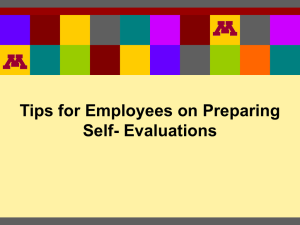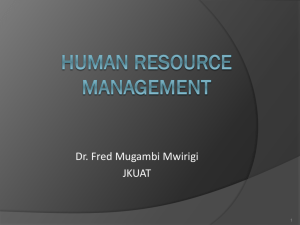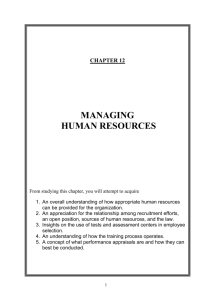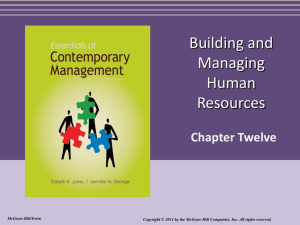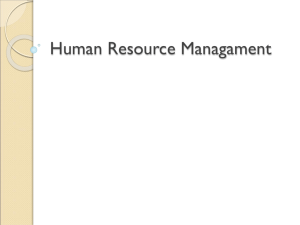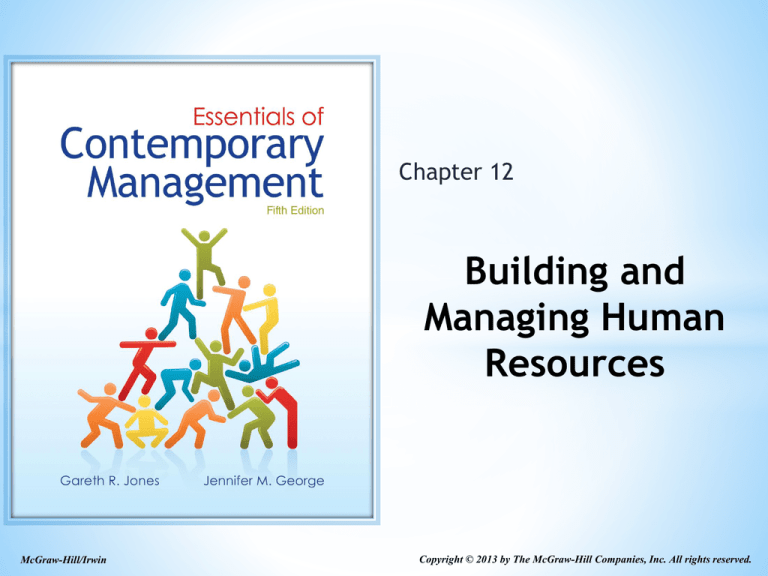
Chapter 12
Building and
Managing Human
Resources
McGraw-Hill/Irwin
Copyright © 2013 by The McGraw-Hill Companies, Inc. All rights reserved.
Learning Objectives
• Explain why strategic human resource management
can help an organization gain a competitive
advantage
• Describe the steps managers take to recruit and
select organizational members
• Discuss the training and development options that
ensure organization members can effectively
perform their jobs
12-2
Learning Objectives
• Explain why performance appraisal and feedback is
such a crucial activity, and list the choices
managers must make in designing effective
performance appraisal and feedback procedures
• Explain the issues managers face in determining in
determining levels of pay and benefits
• Understand the role that labor relations play in the
effective management of human resources
12-3
The management function that is
concerned with getting, training,
motivating, and keeping competent
employees.
• Balancing the supply of employees with the
demand for employees.
• Matching the talents and skills of employees
with those required by the organization.
• Creating a working environment that fosters
high employee performance.
• Meeting the pay and benefits needs of
employees.
4
Strategic Human Resource Management
• Strategic human resource management: The
process by which managers design the components
of a HRM system to be consistent with each other,
with other elements of organizational architecture,
and with the organization’s strategy and goals
• The objective of strategic HRM is the development of
an HRM system that enhances the four building
blocks of competitive advantage.
12-5
Strategic Human Resource Management
• Overview of the components of HRM:
• Recruitment and selection
• Training and development
• Performance appraisal and feedback
• Pay and benefits
• Labor relations
12-6
Strategic Human Resource Management
• Managers use recruitment and selection to attract and
hire new employees who have the abilities, skills, and
experiences that will help an organization to achieve
its goals.
• Careful attention to the selection process can contribute
to a company’s competitive advantage.
• After recruiting and selecting employees, managers use
training and development to ensure that organizational
members develop needed skills and abilities.
• a. Training and development is an ongoing process
because of changes in technology, the environment, and
organizational goals and strategies.
12-7
Strategic Human Resource Management
• Performance appraisal and feedback serve two purposes in
HRM.
a. Performance appraisal serves as a control system that can
provide managers with the information they need to make good
human resources decisions.
b. It also allows managers to regularly evaluate their
subordinates’ performance in order to provide them with
valuable information about their strengths and weaknesses.
c. On the basis of performance appraisals, managers distribute
pay to employees.
d. By rewarding high-performing organizational members,
managers increase the likelihood that these human resources
are motivated to continue their high level of performance and
are more likely to stay with the organization.
12-8
Strategic Human Resource Management
• Benefits such as health insurance are important
outcomes that employees receive by virtue of their
membership in an organization.
• Labor relations encompass the steps that managers
may take to develop and maintain good working
relationships with the labor unions that may represent
their employees’ interests.
• Managers must ensure that all five of these components
fit together and complement their company’s structure
and control systems.
•
Each of the five components of HRM influences the
others.
12-9
The Legal Environment of HRM
• Effectively managing human resources is a complex task for
managers.
• The local, state, and national laws and regulations that
organizations must follow add to the complexity.
• The U.S. government’s commitment to equal employment
opportunity (EEO) has resulted in a number of laws that
managers must follow
• Equal employment opportunity (EEO)
• The equal right of all citizens to the opportunity to obtain
employment regardless of their gender, age, race, country of
origin, religion, or disabilities
• The treatment of individuals in all aspects of employment—
hiring, promotion, training, etc.
—in a fair and nonbiased manner.
12-10
The Legal Environment of HRM
• Equal Employment Opportunity Commission (EEOC)
enforces employment laws
• The Equal Employment Opportunity Commission
(EEOC) is the division of the Department of Justice
that enforces most of the EEO laws and handles
discrimination complaints.
• The EEOC also issues guidelines for managers to
follow to ensure that they are abiding by EEO laws
12-11
Historical Perspective of EEO Legislation
•Changing National Values
•Economic Disparity
•Early Legal Developments
•Civil Rights Act (1866)
•Unemployment Relief Act (1933)
•Executive Order 8802 (1941)
12-12
1–13
The Legal Environment of HRM
• Contemporary challenges for managers include:
• Eliminating sexual harassment
• Accommodating for employees with disabilities
• Dealing with employees who have substance abuse
problems
• Managing HIV-positive employees and employees with
AIDS
12-14
Table 12.1 - Major Equal Employment
Opportunity Laws Affecting HRM
12-15
Recruitment and Selection
• Human resource planning: All activities that managers
engage in to forecast their current and future needs for
human resources
• Current human resources are the employees an
organization needs today
• Future human resources are the employees the
organization will need at some later date.
• Recruitment: All activities that managers engage in to
develop a pool of candidates for open positions
• Selection: The process that managers use to determine
the relative qualifications of job applicants and their
potential for performing well in a particular job
12-16
Recruitment and Selection
• Managers must make both demand forecasts and
supply forecasts.
• Demand forecasts estimate the qualifications and
numbers of employees an organization will need,
given its goals and strategies.
• Supply forecasts estimate the availability and
qualifications of current employees and the supply of
qualified workers in the external labor market.
12-17
Recruitment and Selection
• Managers sometimes decide to outsource to fill
some HR needs.
• Outsourcing is when managers contract with people
who are not members of their organization to
provide goods and services.
• Managers sometimes outsource because it provides
them with increased flexibility and allows them to use
human resources at a lower cost.
• Outsourcing does have disadvantages; managers may
lose some control over the quality of goods and
services.
12-18
The Recruitment and Selection System
12-19
Recruitment and Selection
• Job analysis: Identifying the tasks, duties and
responsibilities that make up a job(job description)
and the knowledge, skills, and abilities needed to
perform the job(job specifications)
• Needs to be done for each job in the organization
• Job analysis methods
• Observing what current workers do or interviewing
them
• Having workers and manages fill out questionnaires
• Job analysis leads to the creation of a job
description
12-20
*
Recruitment and Selection
• External recruiting
• Looking outside the organization for people who have not
worked at the firm previously
• Newspapers advertisements, open houses, on-campus
recruiting, employee referrals, and the Internet
• Advantages: having access to a potentially large applicant
pool, being able to attract people who have the skills and
knowledge desired, and being able to bring in newcomers
who may have a fresh approach to problems.
• Disadvantages: the high cost of external recruitment, the
external recruit’s lack of knowledge about the inner
workings of the organization, and the uncertainty as to
whether they will actually be good performers.
12-24
Recruitment and Selection
• In spite of the many downsizings and corporate
layoffs that have taken place in recent years,
external recruiting remains a difficult task because
job seekers often do not have the skills and
abilities to fill positions that are open.
• Both job seekers and employees are relying with
increasing frequency upon employment websites on
the World Wide Web to make connections with each
other.
12-25
Recruitment and Selection
• Internal recruiting - Managers turn to existing employees to
fill open positions
• Lateral move: A job change that entails no major changes
in responsibility or authority levels
• Benefits of internal recruiting
• Internal applicants are already familiar with the organization
• Managers already know candidates
• Can help boost levels of employee motivation and morale
• Is normally less time-consuming and expensive.
• Disadvantages of internal recruiting
• include a pool of candidates that may be limited, a tendency
among those candidates to be “set” in the organization’s ways,
and a lack of suitable internal candidates.
12-26
Recruitment and Selection
• Selection process
• Managers find out whether each applicant is qualified
for the position and likely to be a good performer
• If multiple candidates meet these two conditions,
managers must determine which are likely to be
better performers than the others.
• They have several selection tools to help them sort
out the relative qualifications and appraise their
potential to be good performers.
12-27
Selection Tools
12-28
Selection Tools
• Background Information:
To aid in the selection
process, managers obtain background information from
resumes and job applications.
• This information can be helpful both to screen out
applicants who are lacking key qualifications and to
determine which qualified applicants are more promising
than others.
• Sometimes background checks can result in unfair
treatment of prospective employees.
• This can happen when databases report inaccurate
information or when employers become biased against an
applicant after learning of a minor conviction that has no
bearing his or her suitability for the job
12-29
Selection Tools
• Interviews: Almost all organizations use interviews
during the selection process.
• In a structured interview, managers ask each
applicant the same standard questions.
• Situational interview questions present interviewees
with a scenario that they would likely encounter on
the job and ask them to indicate how they would
handle it.
• An unstructured interview proceeds more like an
ordinary conversation. Instead of asking fixed
questions, the interviewer asks probing questions to
determine what the candidate is like.
12-30
Selection Tools
• Structured interviews are superior to unstructured
interviews because they are more likely to yield
information that will help identify qualified candidates,
and they are less subjective.
• Even when structured interviews are used, the
potential exists for the interviewer’s biases to
influence his or her judgment. Interviewers, therefore,
must be trained to avoid these biases and other sources
of inaccurate perceptions.
• When conducting interviews, managers cannot ask
questions that are irrelevant to the job in question. If
they do, their organizations run the risk of costly
lawsuits.
12-31
Selection Tools
• Managers can use interviews at various stages in
the selection process. Some use interviews as
initial screening devices; others use them as a final
hurdle that applicants must jump.
• Managers typically use other selection devices in
conjunction with interviews because of the
potential for bias and the formation of inaccurate
assessments by interviewers.
12-32
Selection Tools
• Paper-and-Pencil Tests:
Two kinds of paper-andpencil tests are used for selection purposes.
• Ability tests assess the extent to which applicants
possess skills necessary for job performance, such as
verbal comprehension.
• Personality tests measure personality traits and
characteristics relevant to job performance. Use of
personality tests for hiring is controversial.
• Before using any paper-and-pencil tests, managers
should have sound evidence that the tests are
actually good predictors of performance.
12-33
Selection Tools
• Physical Ability Tests: For jobs that require
physical abilities, such as fire fighting, garbage
collecting, and packaging delivery, physical ability
tests can measure strength and stamina.
• Performance Tests: Performance tests measure job
applicants’ performance on actual job tasks.
• Assessment centers take performance tests a step
further by having applicants participate in a variety
of activities over a few days.
• Throughout the process, current managers observe
the candidates’ behavior and measure performance.
12-34
Selection Tools
• References: Applicants for many jobs are required to
provide references from former employers or other sources
who know the applicants’ skills, abilities, and other
characteristics. These individuals are asked to provide
candid information about the applicant.
• References are often used at the end of the selection process
to confirm a decision to hire.
• Several recent lawsuits filed by applicants have caused
managers to be increasingly wary of providing any kind of
negative information in a reference, even if it is accurate.
• The reluctance of many former employers to provide negative
information in references sometimes makes it difficult to
interpret what a reference is really saying about an applicant.
12-35
Recruitment and Selection
• Whatever the selection tools a manager uses, they
need to be both reliable and valid.
• Reliability: The degree to which a tool or test measures
the same thing each time it is used
• Scores on a selection test should be very similar if the same
person is assessed with the same test on two different days.
• The reliability of interviews can be increased if two or more
different interviewers interview the same candidate.
• Validity: The degree to which a tool or test measures
what it purports to measure
• Managers have an ethical and legal obligation to use
reliable and valid selection tools. However, reliability and
validity are a matter of degree, rather than all-or-nothing
characteristics.
12-36
Training and Development
• Training and development helps to ensure that
organizational members have the knowledge and skills
needed to perform jobs effectively, take on new
responsibilities, and adapt to changing conditions.
• Training: Teaching organizational members how to perform
current jobs and helping them to acquire the knowledge and
skills they need to be effective performers
• Development: Building the knowledge and skills of
organizational members to enable them to take on new
responsibilities and challenges
• Before creating training and development programs,
managers should perform a needs assessment to determine
which employees need training or development and what
type of skills or knowledge to need to acquire.
12-37
Question
What ensures that employees develop the skills and
abilities that will enable them to perform their jobs?
A. Recruitment
B. Selection
C. Assessment
D. Training
12-38
Training and Development
• Needs assessment: An assessment of which
employees need training or development and what
type of skills or knowledge they need to acquire
12-39
Training and Development
12-40
Training
• Classroom Training: Through classroom instruction,
employees acquire knowledge and skills in a
classroom setting.
• This may take place within the organization or out
side it.
• Some organizations establish their own formal
instruction divisions – some are even called colleges –
to provide classroom instruction.
12-41
• On-the-job training: learning occurs in the work
setting as employees perform their jobs.
• Co-workers or supervisors can provide on-the-job
training, or it occurs simply as jobholders gain
experience doing the job.
• Managers of use on-the-job training on a continuing
basis to ensure that their subordinates keep up-todate with changes in goals, technology, products, or
customer needs and desires.
12-42
Development
• Types of Development: Although both classroom
instruction and on-the-job training can be used for
development purposes as well as training,
development often includes additional activities
such as varied work experiences and formal
education.
• Varied Work Experiences:
Top managers need to
understand and have expertise in different functions,
products, and markets.
• To develop managers who will have this expertise,
employees with high potential are given a wide variety of
job experiences in both line and staff positions.
12-43
Development
• With organizations becoming more global, managers need to
develop an understanding of the different values, beliefs, and
cultures, regions, and the way of doing business in different
countries.
• Having a mentor can help managers seek out work experiences
and assignments that will contribute to their development and
gain the most they can from varied work experiences. While some
mentors and protégés connect informally, organizations have
found that formal mentorship programs can make valuable
contributions to the development of managers and employees.
• Many large corporations reimburse employees for tuition
expenses for taking college courses because it is an effective way
to develop employees for more challenging positions.
• To save time and travel costs, managers are increasingly relying
upon long-distance learning to formally educate and develop
employees.
12-44
Development
• Formal Education:
Many large corporations reimburse
employees for tuition expenses they incur while taking
college courses and obtaining advanced degrees.
• This is an effective way to develop employees who are
able to take on new responsibilities and more challenging
positions.
• To save time and travel costs, managers are increasingly
relying on long distance learning to formally educate and
develop employees.
• Videoconferencing technologies are being used to teach
courses on video screens in corporate conference rooms
and business schools are customizing courses and degrees
to fit the development needs of employees in a particular
company.
12-45
Training and Development
• Transfer of Training and Development: Whenever
training and development takes place off the job or
in a classroom setting, it is vital for managers to
promote transfer of the knowledge and skills to the
actual work situation.
12-46
Performance Appraisal
• The evaluation of employees’ job performance and contributions
to their organization
• Traits appraisals
• Behavior appraisals
• Results appraisals
• Objective and Subjective Appraisals: The information upon
which appraisals are based is either objective or subjective.
• Objective appraisal: An appraisal that is based on
facts and is likely
to be numerical
• Subjective appraisal: An appraisal that is based on perceptions of
traits, behaviors, or results
• In addition to subjective appraisals, some organizations employ
forced rankings, in which supervisors must rank their
subordinates and assign them to different categories according to
their performance.
12-47
• Trait Appraisals: When trait appraisals are used, mangers assess
subordinates on personal characteristics that are relevant to job
performance, such as skills, abilities, or personality.
• Because traits do not show a direct association with performance, workers
and courts may view them as unfair and potentially discriminatory.
• Behavior Appraisals:
Through behavior appraisals, managers assess
how workers perform their jobs – the actual actions and behaviors that
workers exhibit on the job.
• Behavior appraisals are especially useful when how workers perform their
•
•
jobs is important.
Behavior appraisals have the advantage of providing employees with clear
information about what they are doing right and wrong and how they can
improve their performance.
Performance feedback from behavior appraisals is more likely to lead to
performance improvements since behaviors are much easier for behaviors to
change than traits.
12-48
*
• Forced-Choice Method
Requires the rater to choose from statements designed
to distinguish between successful and unsuccessful
performance.
1. ______ a) Works hard
2. ______ a) Shows initiative
3. ______ a) Produces poor quality
_____ b) Works quickly
_____ b) Is responsive to customers
_____ b) Lacks good work habits
• Essay Method
Requires the rater to compose a statement describing
employee behavior.
• Results Appraisals: With results appraisals,
managers appraise performance in terms of results
or the actual outcomes of work behaviors.
• Management by Objectives (MBO)
• A philosophy of management that rates performance
on the basis of employee achievement of goals set by
mutual agreement of employee and manager.
12-52
Question
Which of the following types of appraisals is based
on facts and is likely to be numerical?
A. Trait appraisal
B. Behavior appraisal
C. Results appraisal
D. Objective appraisal
12-53
Figure 12.5 - Who Appraises Performance?
12-54
• 360-Degree Performance Appraisals:
In a 360-degree
appraisal, a manager’s performance is appraised by a
variety of people in a position to evaluate the
manager’s performance.
• The manager then receives feedback based on
evaluations from these sources.
• Trust is a critical ingredient if this type of performance
appraisal is going to be effective.
• Research suggests that 360-degree appraisals should focus
on behaviors rather than traits or results, and that
managers need to carefully select appropriate raters.
• Takes great deal of time
12-55
Performance Feedback
• The process through which managers:
• Share performance appraisal information with
subordinates
• Give subordinates an opportunity to reflect on their
own performance
• Develop, with subordinates, plans for the future
12-56
Performance Feedback
• Managers can use both formal and informal appraisals.
• Formal appraisals: An appraisal conducted at a set time
during the year and based on performance dimensions
that were specified in advance
• An integral part of a formal appraisal is a meeting between
the manager and the subordinate in which the subordinate is
given feedback on performance.
• Because they realize the value of performance appraisals,
large corporations have committed substantial resources to
updating their performance appraisal systems and teaching
employees how to correctly use them.
• Informal appraisals: An unscheduled appraisal of ongoing
progress and areas for improvement
12-57
Performance Feedback
• Guidelines for giving effective performance
feedback:
• Be specific and focus on behaviors or outcomes that
are correctable and within a worker’s ability to
improve
• Approach performance appraisal as an exercise in
problem solving and solution finding, not criticizing
• Express confidence in a subordinate ability to
improve
12-58
Performance Feedback
• Provide performance feedback both formally and
informally
• Praise instances of high performance and areas of a
job in which a worker excels
• Avoid personal criticisms and treat subordinates with
respect
• Agree to a timetable for performance improvements
12-59
Pay and Benefits
• Pay
• Includes employees’ base salaries, pay raises, and
bonuses
• Determined by characteristics of the organization
and the job and levels of performance
•
Benefits
• Based on membership in an organization
• Include sick days, vacation days, and medical and life
insurance
12-60
Pay and Benefits
• Pay level: The relative position of an organization’s
incentives in comparison with those of other firms
in the same industry employing similar kinds of
workers
• Pay structure: The arrangement of jobs into
categories based on their relative importance to
the organization and its goals, level of skills, and
other characteristics
12-61
Pay and Benefits
• Benefits
• Legally required - Social security, workers’
compensation, unemployment insurance
• Voluntary - Health insurance, retirement, day care
• Cafeteria-style benefits plans: A plan from which
employees can choose the benefits they want
12-63
Labor Relations
• Labor relations: The activities managers engage in
to ensure that they have effective working
relationships with the labor unions that represent
their employees’ interests
12-64
Question
What are the activities managers engage in to
ensure they have effective working relationships
with unions?
A.Collective bargaining
B.Labor relations
C.Employee negotiations
D.Labor deal
12-65
Labor Relations
• Unions
• Represent worker’s interests to management in
organizations
• The power that a manager has over an individual
worker causes workers to join together in unions to
try to prevent this
• Collective bargaining: Negotiation between labor
and management to resolve conflicts and disputes
about issues such as working hours, wages,
benefits, working conditions, and job security
12-66

